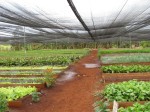In 2009 I was lucky enough to participate in a three-week sustainable agriculture tour in Cuba organized through the University of British Columbia by a woman named Wendy Holm. Wendy is a dynamo who has been running tours to Cuba for Canadian students and farmers since 1999, facilitating the exchange of information about techniques for growing food and raising livestock without chemical inputs.
Cuba is a country of special focus for people interested in sustainable agriculture because it has developed an extensive and innovative system of food production that is not dependant on oil – a fact made more impressive when you consider that oil is used not only to power vehicles, but as the base ingredient in most fertilizers, pesticides and herbicides used in Canada and the US. This system developed following the fall of the Soviet Empire. Due to the US embargo, the USSR had been Cuba’s major trading partner for many years and the source of oil for their industrialized agriculture. Once the USSR collapsed, Cuba was left without an oil supply and without a system for importing food in place.
This plunged the country into a time called the “Special Period” wherein Cuba had to completely redesign their system for producing and distributing goods, moving people, and feeding its citizens. The government turned much of the state owned land in and around cities over to agriculture which, by virtue of the lack of imports, had to be done following organic principles, without chemical fertilizers, herbicides, or pesticides. Backyard gardening was also strongly promoted, and supported by governmental agricultural extension agents who were dispatched to farms in the cities and countryside to educate and build connections between growers. The result of this is that Cuba is home to one of the most highly developed systems of sustainable agriculture in the world, and is a country which many look to as a model for how we will deal with the upcoming oil shortages of the future, or “Peak Oil”.
My 3 weeks in Cuba allowed me to learn a great deal about this fascinating country and its remarkable transition away from oil dependency, especially in light of its unique geopolitical situation. We travelled to urban and rural farms, growing crops for domestic consumption and export. What was fascinating to see was the level of thought put into each aspect of the agricultural system there, both on individual farms, and in terms of the governmental support structure.
Farms in Cuba all had extensive composting systems, many including vermicomposting beds up to 100 feet long. They produced compost for their plants as well as worm leachate which was used as a pest repellent. Every farm utilized a variety of techniques for pest control, from organic sprays and companion planting of repellent plants, to a variety
of traps. Scent traps, to hide the odour of a pest’s target plant, and colour traps, yellow or blue plastic (depending on the colour of the pest’s target plant) distributed throughout the garden on stakes and covered with a sticky substance to catch insects. Another common practice was pasturing animals in orchards, allowing them to graze on grass and weeds growing between the trees. This meant the animals were fed, the trees were fertilized and the weeds were suppressed with no real effort from the farmer.
The importance of governmental support in Cuba cannot be underemphasized. It was the governmental extension agents who disseminated this information among farmers and the government-funded research stations and schools that developed and researched things like tabaquina, a pesticidal spray made of residue from tobacco processing, and mycorrhiza, fungi which grow on plant roots and improve the plant’s ability to absorb water and nutrients from the soil. The amount of land under governmental control was also a decisive factor in the success of urban agriculture in Cuba, as they had huge areas of unoccupied urban land available to be turned over to food production, something that would be impossible with the private landownership in Canada and the US. This vast area under cultivation allows Havana to produce 90% of its fruit and vegetable requirements to be produced within the city’s borders (although, before you’re too impressed by this statistic, keep in mind that the most common meal in Cuba is
rice, beans and pork, with vegetables playing a minor role in the country’s food culture). In addition, governmental control of markets assists farmers in planning and distributing their crops for the season, and educating the public about the medicinal and health benefits of various agricultural products.
Regardless of the fact that the Cuban climate and political structure are very different from our own, there is a lot to be learned from this country, in terms of techniques for growing, systems for supporting farmers, and the wide range of cooperative farming systems seen throughout the country, which I will discuss further in a future post. If you are interested in learning more about Cuba and its experience with “Peak Oil” and sustainable agriculture, check out the links below.
Student Cuban Agricultural Tour Course Site
The Power of Community: Film on Cuba’s Experience with Peak Oil









